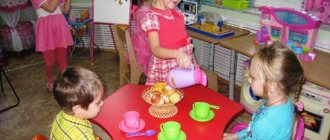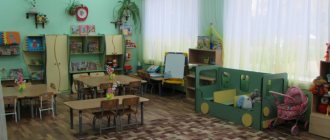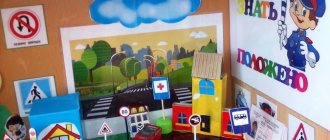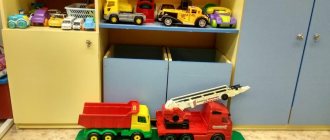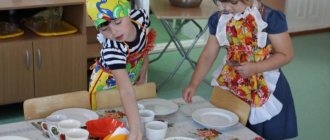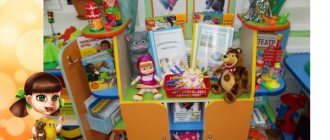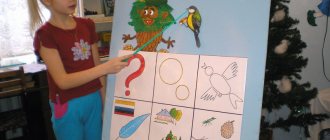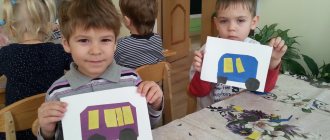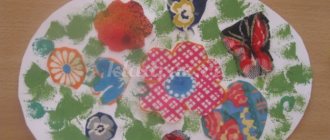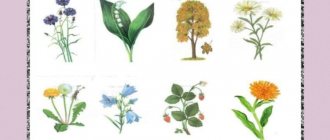Subject-developmental environment in the middle group of kindergarten within the framework of the Federal State Educational Standard
Slide 1 Subject-based developmental environment in the middle group of a kindergarten within the framework of the Federal State Educational Standard. Completed by: Levshakova O.V, teacher of MBDOU “Kindergarten No. 18” “Crane” Specialist of the 1st qualification category
Slide 2 Subject development environment in preschool educational institutions. Particularly relevant today is the issue of organizing the subject-development environment of preschool educational institutions. This is due to the introduction of the Federal State Educational Standard (FSES) to the structure of the basic general education program of preschool education. In accordance with the Federal State Educational Standard, the program should be built taking into account the principle of integration of educational areas and in accordance with the age capabilities and characteristics of students. The solution of program educational tasks is provided not only in the joint activities of adults and children, but also in the independent activities of children, as well as during routine moments. Everyone knows that the main form of work with preschoolers and the leading activity of children is play. That is why we educators are experiencing an increased interest in updating the subject-development environment of preschool educational institutions.
Slide 3 What is a subject-specific developmental environment? (Terminology) The child’s development environment in the structure of the Federal State Educational Standard is a complex of material and technical, sanitary and hygienic, social, social, social, ergonomic, aesthetic, psychological, pedagogical, and spiritual conditions that ensure the organization of the lives of children and adults in preschool educational institutions.
Slide 4 Federal State Educational Standard requirements for a subject-development environment: 1. Accessibility for students of all premises of the organization where the educational process is carried out. 2. Free access for pupils to games, toys, materials, and aids that provide all basic activities.
Slide 5 Factors that should be taken into account when organizing PRS. Children should be protected in every possible way from the negative influence of toys that: provoke the child to aggressive actions and cause cruelty, provoke game plots associated with immorality and violence that are beyond the competence of childhood. Anthropometric factors ensuring compliance of height and age characteristics with the parameters of the subject development environment. Furniture must be in accordance with the requirements of SANPiN and Federal State Standards
Slide 6 The subject development environment should facilitate the implementation of educational areas in the educational process, including: 1) joint partnership activities of adults and children; 2) free independent activity of the children themselves in the conditions of a subject-based developmental educational environment created by teachers, which ensures that each child chooses activities according to his interests and allows him to interact with peers or act individually.
Slide 7 The subject-spatial development environment should be organized taking into account the requirements of the Federal State Educational Standard, where all five educational areas are clearly visible: 1) socio-communicative,
2) educational,
3) speech,
4) artistic and aesthetic,
5) physical.
Slide 8 Approximate centers for educational areas in light of the requirements of the Federal State Educational Standard Social and communicative development: Cognitive development: Speech development Artistic and aesthetic development Physical development: Traffic Safety Center
Fire Safety Center
Labor Center, Duty Corner
Game activity center (center for role-playing games)
Sensory Development Center
Center for Constructive Activity
Center for Mathematical Development
Experimentation Center Speech Development Center or Speech and Literacy Corner
Speech therapy corner Fine Arts Center or creativity corner
Center for Musical and Theatrical Activities Center for Physical Development - Sports Corner “Be Healthy!”
Slide 9 When creating a subject-development environment in our group, we set ourselves the goal of doing this with minimal economic costs, since we cannot count on serious material investments in equipping the subject environment. We tried to make the subject-development environment diverse, bright, and rich in information, in order to maximally speed up and facilitate the adaptation period of children in kindergarten, create an emotionally positive atmosphere in the group, and ensure the individual harmonious development of the child. We followed the zoning principle. Thanks to the organization of various play areas and corners using open shelving that does not clutter the room. The group has created conditions for different types of children's activities (play, productive and cognitive-research). In order for each child to be able to find something to do and do something they like and feel comfortable, centers for a specific type of activity are allocated in the group.
Slide 10 Direction: Artistic and aesthetic development. There is material and equipment for artistic and creative activities: drawing, modeling and appliqué. If desired, the child can find and use what is necessary to realize his creative ideas, plans, and fantasies. This center has free access.
Slide 11 Direction: Speech development plays a significant role in developing children’s interest and love for fiction. In this corner, the child has the opportunity to independently choose a book according to his taste and calmly examine it with bright illustrations.
Slide 12 Direction: Cognitive development. Center for Experimental Activities. It contains material for carrying out experimental activities: magnifying glasses, flasks, measuring cups, funnels, hourglasses, soil, stones, seeds, cereals, etc. Our little “whys” conduct simple experiments and determine the properties of various natural materials.
Slide 13, 14 includes environmental activities. This corner contains various types of indoor plants, which are convenient for demonstrating modifications of parts of the plant, tools for caring for these plants: sticks for loosening, a spray bottle, watering cans, etc. In addition to indoor plants, this center contains models (desert, animal world, aquarium , birdhouse, beehive, birdcage, etc.).
Slide 15 It’s winter outside, but in the group on the windowsill it’s spring. During the cold season, my children and I create a mini-vegetable garden on the windowsill. This is an opportunity for children to have live communication with plants. Anyone who starts such a vegetable garden will certainly become interested in experimentation and eco-design. I arranged the winter garden with great imagination: I designed it in the form of a village yard, decorated it with suitable buildings and decorative accessories.
Slide 16 The “construction” (constructive) center, although concentrated in one place and takes up little space, is quite mobile. Its practicality lies in the fact that with the contents of the construction corner (various types of construction sets, large and small construction sets), you can move to any place in the group and organize this activity.
Slide 17 (toy library) The center solves the following tasks: purposefully developing children’s interest in elementary mathematical activities, instilling in children the need to occupy their free time with not only interesting, but also games that require mental stress and intellectual effort.
Slide 18 Direction: Social and personal development. Play is the main activity of our children. A bright, rich play center creates conditions for children’s creative activity, develops imagination, develops gaming skills and abilities, and fosters friendly relationships between children. Attributes for role-playing games emerging at this age are freely available to children: “Family” “Hospital”
Slide 19 “Barbershop”
"Theater"
Slide 20 “Shop” “Garage”
Slide 21 «
sensory cornermethodological development on the topic
Sensory Corner
"Development"
To conduct classes on sensory development in the middle group, there are puzzles, board games (comparing objects by various properties: color, shape, size, material, properties); pyramids - single-color, multi-colored from 6-8, 12 rings, liner bowls, nesting dolls, game “Color the picture”; wooden toys, cubes, hammers; sounding toys: bells, pipes, squeakers, sounding balls; entertaining toys for the development of tactile sensations: flat animal figures with different surfaces - fur, velvet, silk, sandpaper.
The organization and arrangement of objects of the developmental environment in the sensory corner are carried out rationally, logically and conveniently for children. The arrangement of furniture, playground and other equipment meets the requirements of the Federal State Educational Standard, sanitary and hygienic requirements and safety regulations, the physiology of children, and the principles of functional comfort.
All games and objects in the sensory corner are designed to develop thinking and finger motor skills; development of visual perception and attention; for the purpose of teaching grouping objects by color, size, shape, etc. The main task of sensory didactic games is the accumulation of diverse sensory experience, which in classes in fine art activities and design will allow you to systematize accumulated knowledge, acquire new ones, and also use them in various situations and everyday life.
1. Arrange all games, toys and objects on tables according to lesson topics.
2. For clarity, you can stick geometric shapes of different sizes and numbers on the walls.
3. Change the set of games once every two months.
Construction Corner “Creative Kaleidoscope”
According to the Federal State Educational Standards, the group is equipped with spaces for play, construction, etc., as well as a variety of materials, games, toys and equipment that ensure free choice for children. The purpose of the design corner is to develop children’s creative potential, develop interest in artistic activities, develop aesthetic perception, imagination, artistic and creative abilities, independence, and activity.
In the corner there is the following construction material: a LEGO “Duplo” construction set with colored cards, visual models and diagrams, a wooden and plastic construction set, soft modules, plasticine. All material is classified by shape and size and stored in specially designated boxes. Large floor building materials are placed in the group's play area, as the free space on the floor makes it possible to build structures that children love to climb into and play with.
Building material is stored in the boxes in which it was purchased. All finished crafts are placed on a special rack in the shape of a ladder. You can also suggest playing with other furniture (tables and shelves) and harmoniously fitting it into the interior of the entire group.
To store boxes of construction materials, you can designate a part of the learning area where construction materials will be located. In order for the corner to have an aesthetic appearance and for ease of use, small images of the items they contain are pasted on the boxes.
You can put natural material in the boxes to make crafts, which children and parents collect themselves on walks. The inside of the box can be divided into cells, for example for storing acorns, seeds or threads, buttons.
Other types of corners
It should be noted that in the middle group of kindergarten, corners according to the Federal State Educational Standard will also be on topic. They can be equipped with special standards and other information that will be useful for educators and teachers. Such stands should not be ignored, as they are the most informative. They can also be beautifully designed to attract children's attention.
The art corner in kindergarten in the middle group is also in demand. Children will be pleased if, after some competition, their works are hung on this stand. It should be noted that parents who come to the room will also rejoice and look at the drawing their child has drawn. Therefore, if the room allows, such a stand should be installed.
Important details for corners
In order to make corners in kindergarten in the middle group, you need to pay attention to some nuances. Here there must be simple recommendations that will indicate how to improve the health of children. These may be prescribed preventive measures or some other points that parents sometimes forget about. An obligatory component of such a corner should be information for the children themselves, that is, it is necessary to include some children’s sections or beautiful pictures. This is the only way to interest such a young viewer. Fairy-tale characters will do a great job promoting a good lifestyle, where children will emphasize the most new aspects of life for themselves. While washing or exercising, children will see and follow all the rules and recommendations.
The corner's children's pages should be as visible as possible. It is also better to diversify the stand with some drawings from the children themselves, which they will make on the topic of health.
Accordingly, you can build a parent’s corner in the middle group of a kindergarten, which will be useful for children too. If you put up a physical education stand, you can highlight all the information that will describe all the moments related to sporting events, relay races, competitions that will develop children. These could be sports results or photographs of children.
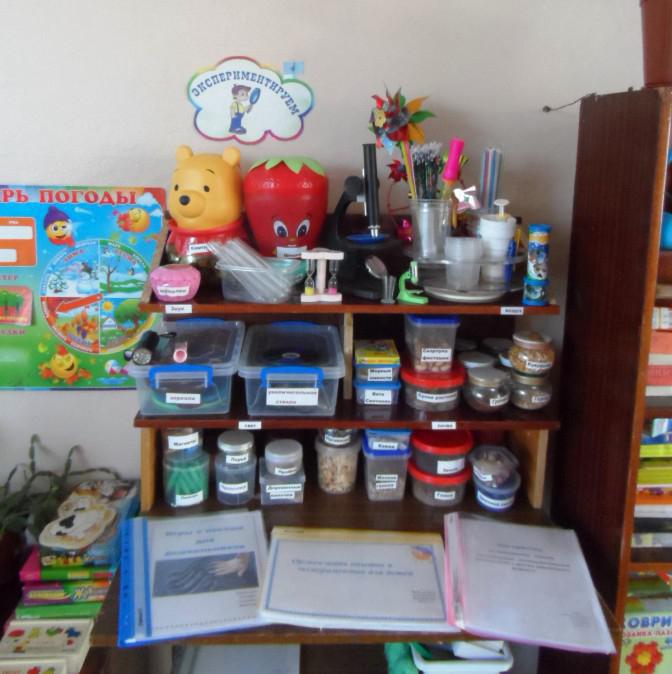
What plants and animals should I buy for the corner?
When creating corners in kindergarten in the middle group, you need to take care of the inhabitants of the living corner. Among the vegetation, you need to choose expressive plants that will have a bright appearance in order to keep the attention of the kids. They should also be unpretentious and as safe as possible. It is advisable to choose different types so that children understand that even plants have individuality. It is necessary to place plants so that they do not look intrusive, but so that, on the contrary, they create comfort in the group.
You also need to consider maximum lighting and humidity. For example, violets and begonias will not do well in direct sunlight, while cacti and geraniums like a lot of light. Also, don’t forget that children should have maximum access to plants so that they can easily care for them. As for preferred plants, it is better to choose prickly aloe, agave, asparagus or begonia. Children in the middle group will care for several types of indoor plants at once.
If we talk about pets, then the corners in kindergarten in the middle group should include turtles, lizards or ordinary fish in aquariums. You can get a furry rodent. As a rule, hamsters, mice and guinea pigs attract the attention of visitors more. They are very cute and unpretentious. In addition, these animals can be trained a little.
